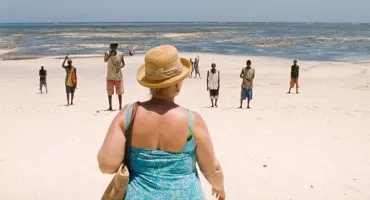
Source: Official Film Site
Two years after its debut at the Cannes Film Festival, the excellent movie Paradise: Love finally made it to movie theaters in Costa Rica. Lovingly directed by Austrian filmmaker Ulrich Seidl, Paradise: Love tells the story of Theresa, a middle-aged European woman who travels to Kenya in search of hunky young Africans who are more than willing to indulge her sexual desires as long as they get paid.
Paradise: Love was part of a recent European Film festival that took place at Cine Magaly in downtown San Jose. Speaking to La Nacion, Marcelo Quesada of film distribution label Pacifica Grey explained that the film exposed the world of sexual tourism from a different angle; when the “johns” are actually “janes,” things are just slightly different. While Mr. Quesada knew that this movie would have a positive impact among viewers in Costa Rica, he probably did not expect an energetic standing ovation that lasted a few minutes when the credits rolled at the end.
There is something interesting about the standing ovation that Paradise: Love received at Cine Magaly. Female sexual tourists are known to visit Costa Rica, and they usually head straight for Puerto Viejo in the Caribbean coast. This social trend has been studied at length by a leading Canadian researcher, and it was reported by The Costa Rica Star when Paradise: Love was shown at Cannes. Here’s a reprint of that article along with a recommendation to watch the film.
The Gigolos of Puerto Viejo: Ladies Pursue and Buy Romance in Costa Rica
Every year at the Cannes Film Festival, a single screening manages to polarize audiences. This time the founder of the Sea Shepherd Conservation Society Paul Watson, who is fighting an extradition to Costa Rica, is trying to take the spotlight with his 2011 documentary “Confessions of an Eco-Terrorist“, and to that extent celebrity guests -including American actress Michelle Rodriguez– planned a gathering at the ritzy Hotel Martinez Beach to rally support for Mr. Watson.
Confessions of an Eco-Terrorist will not steal the buzz at Cannes because “Paradise: Love“, a film by Austrian director Ulrich Seidl, has already done so. Paradise: Love promises to be the first film in a trilogy about a subject that many consider taboo, but in the end is as primal as desire itself: women engaging in sex tourism.
Reviews of Paradise: Love are in, and they are mixed. The Guardian (UK) describes the plot about an Austrian middle-aged woman who travels to Kenya to find romance, which she finds at the right price. The film has polarized critics and film audiences at the festival for two reasons: explicit sex scenes and the overall theme of Western women traveling to remote parts of the world looking for intimacy.
Paradise: Love is not the first time the subject has been depicted on the silver screen. There’s Heading South, starring Charlotte Rampling as part of a trio of lonely middle-aged women from the United States and Canada and their high libidos in 1970s Port-au-Prince. Just like in Paradise: Now, a tropical beach and dark-skinned young men serve as the backdrop of the film. Both films also share an underlying theme of romance between the male prostitutes and the female johns (janes?) who love them, as well as the eventual pitfalls thereof.
The theme and setting of both films could be transferred to Costa Rica, precisely to the Caribbean village of Puerto Viejo, where an anthropologist has studied the practice of sex tourism by women who arrive looking for the paid company of younger Afro-Costa Rican men.
The Many Facets of Puerto Viejo
Regular readers of The Costa Rica Star are probably familiar with the many facets and issues of Puerto Viejo. It is a thriving community enjoyed by many expatriates, tourists and locals; it has experienced uneasy and uneven growth and residents have expressed concerns over crime, sanitation, environmental protection, and complex land ownership matters. Reading those articles back-to-back one would give the idea of Puerto Viejo as a troublesome place, but the reality is that the community has simply developed very fast and unevenly -a trait common to practically all of Costa Rica. As with other communities where development is blazing-fast and sketchy, reports of growing pains such as crime and garbage tend to be magnified.
The idea of Puerto Viejo being a hotbed for female sex tourists like the beaches of Kenya and Haiti depicted in the above-mentioned films is probably exaggerated. No one should expect to find gigolos milling about suggestively in the sand, or women cruising in search of them. There is, however, evidence of the practice as investigated by Dr. Susan Frohlick, Professor of Cultural Anthropology at the University of Manitoba in Canada. She is a leading authority on anthropological studies of sex tourism in Puerto Viejo.
Dr. Frohlick has written about her ethnographic investigations of tourism in Puerto Viejo in various publications and research papers. On Fluid Exchanges (ahem): The Negotiation of Intimacy between Tourist Women and Local Men in a Transnational Town in Caribbean Costa Rica, Dr. Frohlick writes about Puerto Viejo in her abstract as follows:
“In a transnational tourist town in black Caribbean Costa Rica situated both on the margins of “white” Costa Rican society and squarely in global tourism, the mobility of European and North American women tourists in and out constitute a significant tourist flow. Central to the town’s social sexual history and modes of sociability are economically ambiguous sexual and often intimate relations between female tourists and local predominantly black Caribbean men.”
The Dynamics of Women as Sex Tourists
In another study, Negotiating the public secrecy of sex in a transnational tourist town in Caribbean Costa Rica, Dr. Frohlick assumed the alleged role of a sex tourist simply by arriving as an unaccompanied woman in Puerto Viejo. Contributing to the book Thinking Through Tourism, she writes in anecdotal fashion about the tragic saga of two young American women who were shot to death in Puerto Viejo at the beginning of the 21st century. Dr. Frohlick points out that while there is no evidence that the two murdered women were sex tourists, there was a dichotomy exhibited by the locals who reacted to the news of the gruesome murders.
A lot was speculated about the sexuality of the murdered women. Testimony of the locals regarding the perceived characters of the victims, Emily Howell and Emily Eagan, was that they were sexual libertines. The testimonies and international press coverage nearly chastised the young American women who were murdered while enjoying the nightlife.
Judgment was passed on this women, just as judgment is passed on female sex tourists everywhere. The dichotomy consists in the underhanded applause that women sex tourists receive from a feminist point of view on one hand, along with accusatory tones on the other hand telling them to stay home and not be sexual unless they want something bad to happen to them.
Costa Rica is not alone in pointing fingers at female sex tourists, at least when they aren’t looking. Dr. Frohlick talks about stereotypes, and they mostly involve middle-aged women with a bit of financial advantage -at least during their vacation- and their assumed preferences in men: Dutch women and Balinese men, Japanese women and Kuta surfers, Canadian women and Afro-Costa Rican gigolos, etc.
For all the finger-pointing and public secrecy that surrounds sex tourism by women, there is one fact that is tackled by the films above and by Dr. Frohlick: a good number of women who engage in sex tourism are actually looking for intimacy and romantic love, and it sometimes happens.
In her study Pathos of Love in Puerto Viejo, Costa Rica: Emotion, Travel and Migration, Dr. Frohlick looks at women who may start off as sex tourists, but whose experiences turn them into new bona fide residents of the community:
“Northern tourists seek out belonging, emplacement and attachment in the global South for reasons to do with love. I draw upon research in Costa Rica with European and North American women whose emotional subjectivity, I suggest, shape their mobility shift from tourist to migrant. I show how emotion, travel and migration are linked, and how cultural and transcultural notions of ‘love’ profoundly affect migration experiences.”
Love, in the end, is a major factor in the sex tourism experience for women. At a time when we, as members of modern society, are becoming jaded and too self-regarding for our own good, we should consider as refreshing the fact that love is springing forth from dalliances originally destined to be business transactions.




